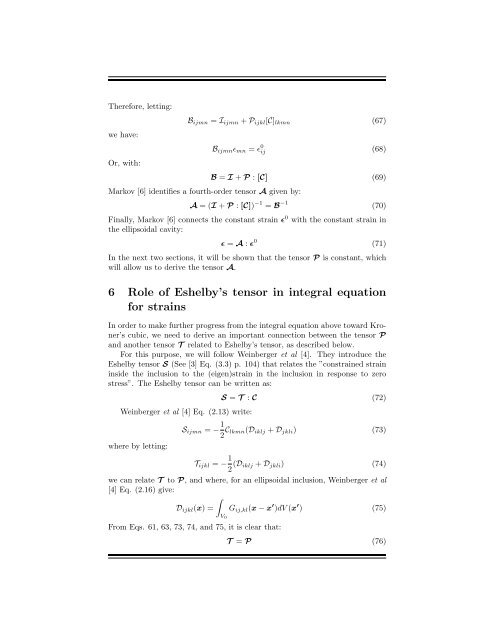You also want an ePaper? Increase the reach of your titles
YUMPU automatically turns print PDFs into web optimized ePapers that Google loves.
Therefore, letting:<br />
we have:<br />
Or, with:<br />
B ijmn = I ijmn + P ijkl [C] lkmn (67)<br />
B ijmn ɛ mn = ɛ 0 ij (68)<br />
B = I + P : [C] (69)<br />
Markov [6] identifies a fourth-order tensor A given by:<br />
A = (I + P : [C]) −1 = B −1 (70)<br />
Finally, Markov [6] connects the constant strain ɛ 0 with the constant strain in<br />
the ellipsoidal cavity:<br />
ɛ = A : ɛ 0 (71)<br />
In the next two sections, it will be shown that the tensor P is constant, which<br />
will allow us to derive the tensor A.<br />
6 Role of Eshelby’s tensor in integral equation<br />
for strains<br />
In order to make further progress from the integral equation above toward <strong>Kroner</strong>’s<br />
cubic, we need to derive an important connection between the tensor P<br />
and another tensor T related to Eshelby’s tensor, as described below.<br />
For this purpose, we will follow Weinberger et al [4]. They introduce the<br />
Eshelby tensor S (See [3] Eq. (3.3) p. 104) that relates the ”constrained strain<br />
inside the inclusion to the (eigen)strain in the inclusion in response to zero<br />
stress”. The Eshelby tensor can be written as:<br />
Weinberger et al [4] Eq. (2.13) write:<br />
where by letting:<br />
S = T : C (72)<br />
S ijmn = − 1 2 C lkmn(D iklj + D jkli ) (73)<br />
T ijkl = − 1 2 (D iklj + D jkli ) (74)<br />
we can relate T to P, and where, for an ellipsoidal inclusion, Weinberger et al<br />
[4] Eq. (2.16) give:<br />
∫<br />
D ijkl (x) = G ij,kl (x − x ′ )dV (x ′ ) (75)<br />
V 0<br />
From Eqs. 61, 63, 73, 74, and 75, it is clear that:<br />
T = P (76)



